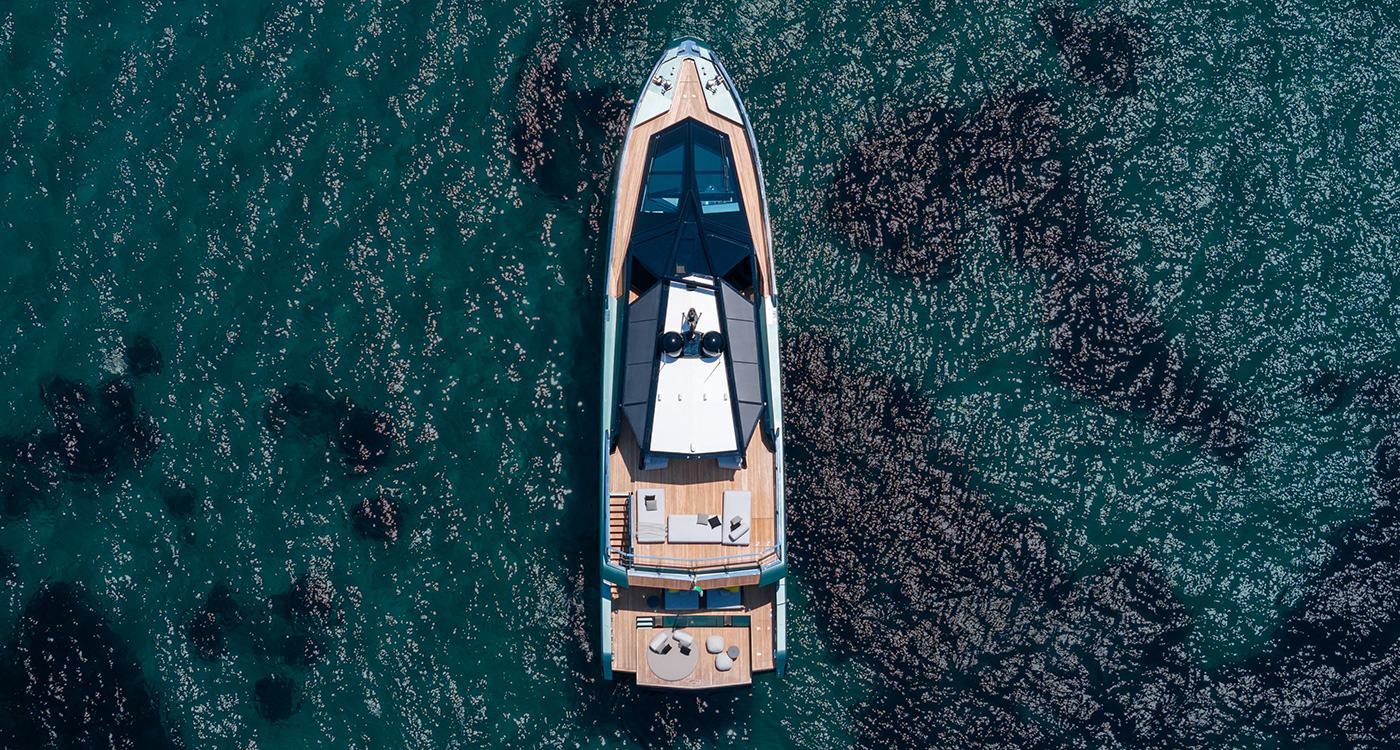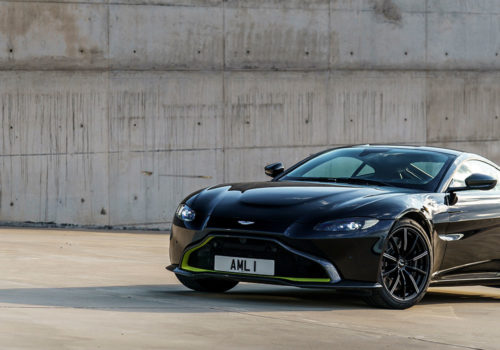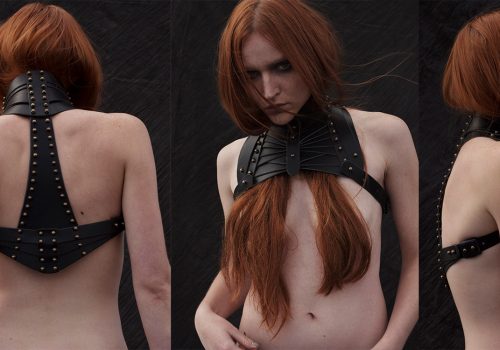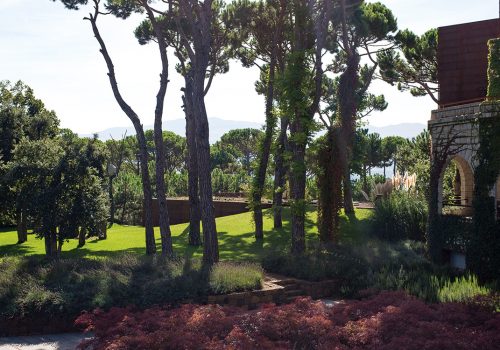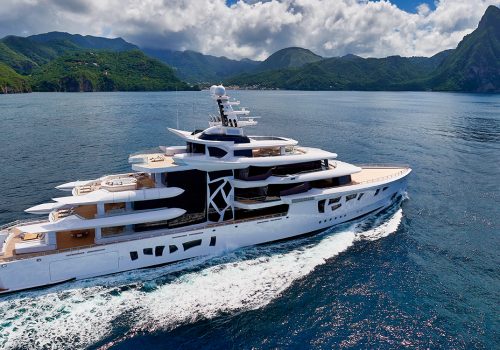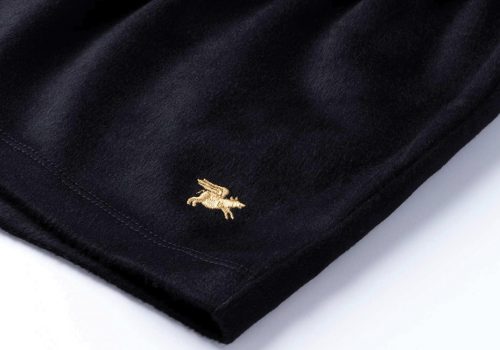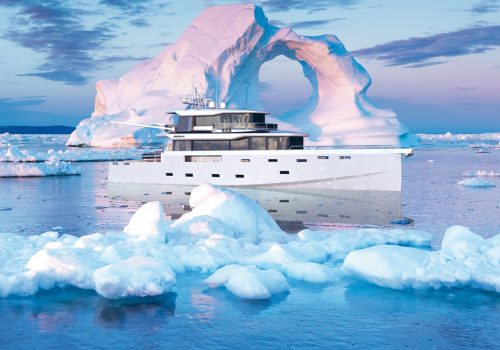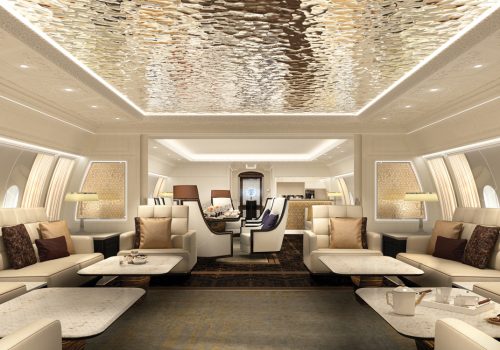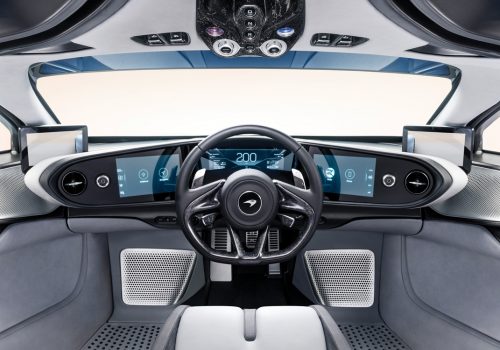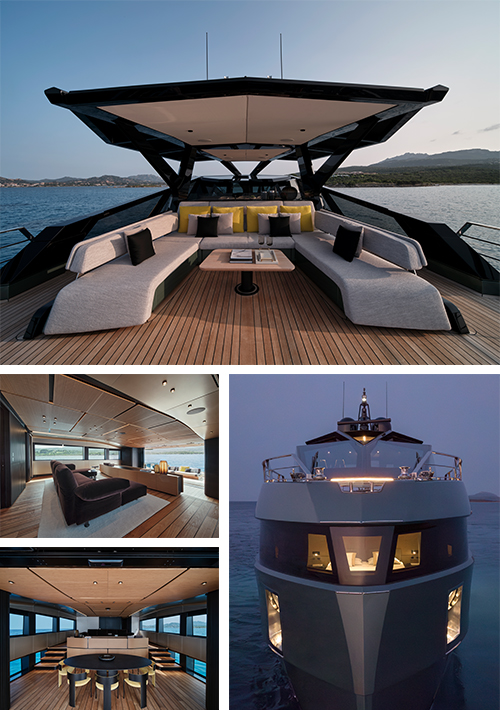
ABOVE TOP: The upper deck has two access points with a staircase leading up from the captain’s helm and another from the aft deck. ABOVE MIDDLE: The upper lounge with its comfy seating for relaxing with a book, enjoying a quiet drink or partaking in a private conversation. ABOVE BOTTOM: The lower area of the main deck salon can either be specced with a bar or with a dining table (as shown here) but you can also switch it with the sofa seating from the upper salon, should you prefer that configuration. ABOVE RIGHT: Adding incredible strength to the structure, the glass used in the main deck’s wraparound windows is of a type and thickness that you’d normally only ever find on a superyacht.
Wally launched the WallyWHY series in the summer of 2022 with the debut of the 200. The name was formed with the ‘W’ standing for Wally, the ‘H’ for hybrid and the ‘Y’ for yacht, and the 200 ushered in a bold new chapter in wide-bodied yachts for the Ferretti group. Of course, other yacht builders have since followed suit, but none of their products have been as innovative as the WallyWHY.
The latest WallyWHY is the 150, which we toured with its designers at the Fort Lauderdale International Boat Show in October. It shares some of the traits of the larger 200, such as the arrow-shaped forward section of the vessel, the open stern and even the master suite in the bow, but that’s where the family resemblance ends.
“It’s completely different inside,” says Andrea Vallicelli from Studio Vallicelli Design, who, along with his son Michelangelo, designed the interior of both yachts. “It doesn’t have the same kind of interior space as the 200, which naturally means that the owner and guests will live differently on this one.” First things first. The numbers on the WallyWHY family refer to interior volume (the 200 means 200 gross tonnes and 150 is 150 gross tonnes) rather than a hull length – the traditional way to measure boats. Wally believes designating the amount of space rather than length makes more sense for its wide-bodied yachts and the trend seems to be gaining momentum, with Sunseeker deciding to name its new Ocean 182 after its gross tonnage, given it was built on the same hull as the last generation Sunseeker Ocean 90 (for 90 feet LOA), but with a vastly different interior and exterior design.
While it may at first seem confusing, using volume as the designator makes sense when you consider the WallyWHY 200’s length is 27m (88 feet), while the new 110 is just three metres smaller at 24m (78 feet), yet it possesses just under half the interior space.
One of the most interesting areas of the WallyWHY 150 is the back half of the boat, with an open stern defined by teak decking. A huge chunk of the aft section, easily a third, descends two meters into the water, creating a platform that’s ideal for launching/retrieving the tender, or for water sports. In the forward section of the aft deck area is a lounge with a convertible seat-back that faces either way, providing entry to the salon. Floor-to-ceiling doors, which fold into the sides, create a seamless entryway between the exterior and interior.
This fluidity between the two spaces really differentiates this new Wally from other yachts. “It was a big challenge,” says Michelangelo Vallicelli. “You might think it’s easy but there were a lot of regulations that needed to be followed to bring it all to code. It was worth it though, as having one level was intrinsic to Wally so you retain the feeling that the inside and outside are a homogenous space.”
The salon itself is an ingenious work of art by the father-son team. “The ceiling is not only curved on its longitudinal side, but also along its far sides,” says Michelangelo. “The idea was to create a dynamic space, where it changes shape and geometry depending on where you are sitting. That sense of dynamism was very important to achieve.”

ABOVE CENTRE: While the hard top can’t be stowed, the upper deck provides the amount of outdoor space you’d normally find on a 40-metre. ABOVE LEFT: Vision from the captain’s helm is limited. ABOVE RIGHT: But the views from the main salon are a joy to behold.
The lower salon has 2.5 metres of headroom, which is the most ever in this class of boat. While, the upper level, accessed via matching sets of four steps on either side of a two-metre-high divider, is another premium feature. The designers say the levels are interchangeable, giving the owner the ability to place a dining table on either one, depending on personal preference. “The dual levelling offers both privacy and sociability,” adds Michelangelo.
The Vallicellis’ ability to disguise technical features is also commendable. In the salon, for instance, they needed to mask the ungainly engine-room bulkhead, and did so by creating a stylish, wooden-panelled, mid-century, modern looking divider that not only separates the two rooms but is an artistic centrepiece.
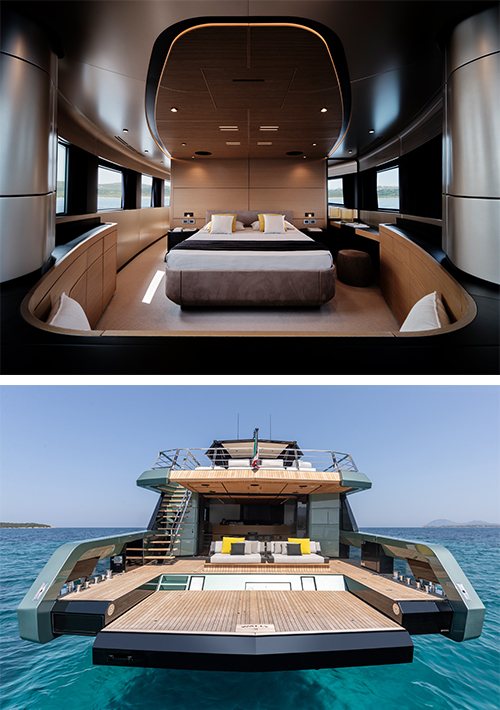
ABOVE TOP: The main deck’s master cabin has astonishing views. ABOVE BOTTOM: A substantial section of the beach club platform drops on actuators to present an appealing submersible swim platform. It also provides access to the neatly concealed transom tender garage.
Likewise in the master suite at the bow. Wally’s engineers chose an anchoring system that could have left two clunky-looking pillars on either side but instead of trying to hide them, the designers clad them in carbon fibre, which allowed them to not just appear stylish but integral to the design of the master suite. It’s a nice touch in a very distinctive room that includes a cocoon-like wooden frame around the bed and 180-degrees of windows including one facing straight forward.
The lower deck is where you’ll find the galley, three guest rooms and – via a separate entrance – the crew quarters for two. On the upper deck is the helm station – with two cool-looking, high-backed carbon-fibre seats from the Wallypower 58 – and sculpted windows that give it an authentic Wallypower stealth look. Unfortunately, visibility for the skipper isn’t great from the pilothouse so Wally integrated video cameras into the hull sides that deliver views from multiple angles.
Fortunately, the 150 was designed to be fuel-efficient, with a range of 1,000 nautical miles at 10 knots. And it can plane at 23 knots
should speed be needed, thanks to the might of three 1,000 horsepower Volvo IPS 1350 engines (although you’ll burn through the boat’s 9,000 litres of fuel in just 360 miles at those speeds). Still, optional Humphree stabilizing fins and trim tabs as well as a Seakeeper 26 gyro-stabilizer, mean rock-and-roll is minimal.
Behind the enclosed pilothouse, the open flybridge exudes a Mediterranean ambiance, with an open aft section that has a lounge with freestanding sofas, as well as a covered section that features a wetbar and dining table. It’s a space for relaxation and privacy, with the omniscient teak decks and carbon-fibre trim showing Wally’s DNA.
Next year, a third member of the Wally hybrid family will emerge – a 100. Michelangelo Vallicelli says it will be more of a dayboat than large cruiser. “It’s an entirely different concept,” he says. “With so much less space you can’t just mimic the larger boats.” Even so, one can bet that Wally quality and innovation will be key parts of the new boat’s DNA.
PHOTOGRAPHY: GILLES MARTIN-RAGET


